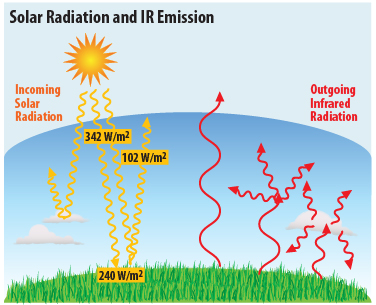Global Temperatures
Overview
Global climate change is a change in the long-term weather patterns that characterize the regions of the world. The term "weather" refers to the short-term changes in temperature, wind, and/or precipitation of a region. Weather is influenced by the sun. The sun heats Earth's atmosphere and its surface, causing air and water to move around the planet. The result can be as simple as a slight breeze or as complex as the formation of a hurricane.

Left: Hurricane Katrina near peak strength on Aug. 28, 2005. http://en.wikipedia.org/wiki/Hurricane_Katrina
Some of the sun's incoming short wave radiation is reflected back to space by aerosols. Aerosols are very small particles of dust, water vapor, and chemicals in Earth's atmosphere. In addition, some of the sun's energy that has entered Earth's atmosphere is reflected into space by the planet's surface. The reflectivity of Earth's surface is called albedo. Both of these reflective processes have a cooling effect on the planet.
The greenhouse effect is a warming process that balances Earth's cooling processes. During this process sunlight passes through Earth's atmosphere as short wave radiation. Some of the radiation is absorbed by the planet's surface. As Earth's surface is heated, it emits long wave radiation toward the atmosphere where it is absorbed by certain gases called greenhouse gases. These gases include carbon dioxide (CO2), chlorofluorocarbons (CFCs), methane (CH4), nitrous oxide (N2O), tropospheric ozone (O3), and water vapor (H2O [g]). Each molecule of greenhouse gas becomes energized by the long wave radiation. The energized molecules of gas then emit heat energy in all directions. By emitting heat energy toward Earth, greenhouse gases increase Earth's temperature. Note that the warming mechanism for the greenhouse effect is NOT exactly the same as the warming mechanism of greenhouse walls. While greenhouse gases absorb long wave radiation, then emit heat energy in all directions, greenhouse walls physically trap heat inside of greenhouses and prevent it from escaping to the atmosphere.
 The greenhouse effect is a natural occurrence that maintains Earth's average temperature at approximately 60 degrees Fahrenheit. It is a necessary phenomenon that keeps all of Earth's heat from escaping to the outer atmosphere. Without it temperatures would be much lower than they are now, and the existence of life as we know it on this planet would not be possible. However, increasing greenhouse gases in Earth's atmosphere could increase the greenhouse effect. This could result in an increase in mean global temperatures as well as changes in precipitation patterns.
The greenhouse effect is a natural occurrence that maintains Earth's average temperature at approximately 60 degrees Fahrenheit. It is a necessary phenomenon that keeps all of Earth's heat from escaping to the outer atmosphere. Without it temperatures would be much lower than they are now, and the existence of life as we know it on this planet would not be possible. However, increasing greenhouse gases in Earth's atmosphere could increase the greenhouse effect. This could result in an increase in mean global temperatures as well as changes in precipitation patterns.
When weather patterns for an area, influenced by temperature, change in one direction over long periods of time, they can result in a net climate change for that area. The key concept in climate change is time. Natural changes in climate usually occur over such long periods of time that they are often not noticed within several human lifetimes. This gradual nature of the changes in climate enables plants, animals, and microorganisms on Earth to evolve and adapt to the new temperatures, precipitation patterns, etc.
The real threat of climate change lies in how rapidly the change occurs. Scientists are in agreement that global temperatures have increased about 0.8 degrees Celsius since 1900. These temperature changes are depicted in the graph of global land-ocean temperatures shown below from NASA’s GIS Surface Temperature Analysis. The graph show that increases in mean global temperature have occurred recently at greater rates. Further evidence suggests that future increases in mean global temperature may occur at a rate of 0.4 degrees Fahrenheit (0.2 degrees Celsius) each decade.

Image description: This graph illustrates the change in global surface temperature relative to 1951-1980 average temperatures. Global surface temperatures in 2012 were the ninth warmest on record. (Source: NASA/GISS) The gray error bars represent the uncertainty on measurements. This research is broadly consistent with similar constructions prepared by the Climatic Research Unit and the National Atmospheric and Oceanic Administration.
The geological record–the physical evidence of the results of processes that have occurred on Earth since it was formed–provides evidence of climate changes similar in magnitude to those in the maps above. This means during the history of Earth, there have been changes in global temperatures similar in size to these changes. However, the past changes occurred at much slower rates, so they were spread out over long periods of time. The slow rate of change allowed most species enough time to adapt to the new climate. The current and predicted rates of temperature change, on the other hand, may be harmful to ecosystems because these rates of temperature change are much faster than those of Earth's past. Many species of plants, animals, and microorganisms may not have enough time to adapt to the new climate. These organisms may become extinct.



